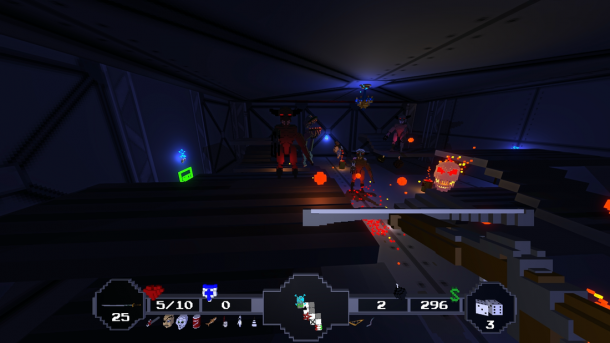A first person rougelike modeled to look like a distant cousin of id Software games, Paranautical Activity takes inspiration from a large amount of different properties. However, it seems that Paranautical Activity borrowed so much that it forgot to put in anything new.
Paranautical Activity starts with the assumption that the player has experienced a rougelike before. Its gameplay demands that players fight their way through numerous enclosed rooms to find the room that has a boss monster in it, kill it and then take an elevator up to another floor to do the same thing over again. It’s a premise that almost all games of this type have, but Paranautical Activity never once does anything to indicate that.
Rooms are tight, claustrophobic arenas randomly generated for each run. Excluding the starting room and any shop rooms where players can spend the money earned from fighting enemies, each one is filled with a random assortment of enemies. Because of this randomness rooms can be seemingly unfair, causing things like small enemies to spawn in areas that the players themselves can’t actually move to. This is compounded by the fact that the game hitches every time a new room is entered and enemies spawn, often causing them to be right on top of the player before they have a chance to do anything. Once players do have control, they may find themselves unable to respond quickly enough to the situation through no fault of their own. Even with the aiming slider all the way up I never felt like I could aim fast enough.

Boss enemies it will drop a power up upon defeat, and more of these items can be unlocked by completing challenges or buying them in shop rooms. These alter your abilities somewhat and are supposedly random, however, six out of eight runs playing as ‘The Tank’ (a character class that does decent damage and gives the highest starting health but makes movement slower) the first two floors bosses only dropped items that though they gave me more health, made my character’s movement even slower. Those drops are a death sentence for that specific class, making an already inept movement system even more cumbersome by making it impossible to evade enemies that move quickly towards you. Technically players could avoid these pickups, but avoiding pickups in fear that they might negatively impact a run will make later levels exponentially difficult.
Speaking of later levels, if a player makes it to Level 5 they will come out of the elevator to be greeted by Nazi imagery. I understand Paranautical Activity is based off of the likes of Doom and Wolfenstein but after sitting through numerous runs of Lovecraftian horror to reach that milestone, only to be rewarded with Nazis and the occult because those games dabbled in it, seems completely out of place and borderline insulting.
And that is at the core of what may be Paranautical Activity’s problem: there is nothing to look foreword to, since we’re always looking back. What makes the rougelike genre so entertaining is that how over time a player learns how to master the game’s movements while also using its systems against itself, in turn allowing them to take on harder challenges and learn even more about the game. Paranautical Activity puts the player at such a disadvantage that advancing through levels feels like less of an accomplishment and more like a lucky roulette spin. Even on these lucky runs, nothing later in the game comes close to inspiring a feeling of needing to get back to there. Extreme difficulty is something that certain gamers look for when choosing something to play, and there are so many rougelikes that nail that difficulty and gameplay fundamentals balance.
Not here, though. Historical gaming influence is appreciated, but when it becomes more of a focus than the gameplay it ends up feeling so completely one-sided towards punishing us that it’s hard to even consider recommending Paranautical Activity unless we want to break ourselves.
Paranautical Activity was reviewed on the Wii U using a retail code provided to Sidequesting. The game first appeared on Steam in 2014.
About the Reviewer: Sam is well-versed in classic PC and console games, and dabbles in a variety of modern “retro” gaming and roguelike experiences.



No Comments